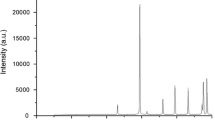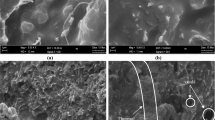Abstract
The surface of sol–gel-synthesized nano-alumina (Al2O3) was modified by three types of silane coupling agents with different specific functionalities, namely 3-aminopropyltriethoxysilane (APTES), triethoxy(octyl)silane (OCTEOS) and bis[3-(triethoxysilyl)propyl]tetrasulfide (TESPT). The aim of the present study was to explore the effect of both unmodified and surface-modified nano-Al2O3 on the cure characteristics, mechanical properties, cross-link density and thermal stability of natural rubber (NR) nanocomposites. Results revealed that silane coupling agents were very effective to enhance maximum rheometric torque (R∞) and mechanical properties like modulus and tensile strength of nano-Al2O3-based NR nanocomposites. APTES offered higher value of cure rate index for NR compounds as compared to two other silane coupling agents. Among three silane coupling agents, TESPT provided highest improvement in the mechanical properties of NR/nano-Al2O3 composites. This might be explained by considering excellent improvement in the cross-link density of NR compounds in the presence of TESPT-treated nano-Al2O3. The incorporation of both TESPT- and OCTEOS-modified nano-Al2O3 into the NR matrix markedly improved the thermal stability of NR composites. Moreover, bi-functional silane TESPT not only increased the hydrophobicity of nano-Al2O3, but also improved the probability of sulfur cross-linking during cure process of NR compounds.









Similar content being viewed by others
References
Ismail H, Ramly F, Othman N (2010) Multiwall carbon nanotube-filled natural rubber: the effects of filler loading and mixing method. Polym Plast Technol Eng 49:260–266
Kueseng P, Sae-oui P, Rattanasom N (2013) Mechanical and electrical properties of natural rubber and nitrile rubber blends filled with multi-wall carbon nanotube: effect of preparation methods. Polym Test 32:731–738
Ismail H, Salleh SZ, Ahmad Z (2011) Curing characteristics, mechanical, thermal, and morphological properties of halloysite nanotubes (HNTs)-filled natural rubber nanocomposites. Polym Plast Technol Eng 50:681–688
Sookyung U, Nakason C, Thaijaroen W, Vennemann N (2014) Influence of modifying agents of organoclay on properties of nanocomposites based on natural rubber. Polym Test 33:48–56
Viet CX, Ismail H, Rashid AA, Takeichi T, Thao VH (2008) Organoclay filled natural rubber nanocomposites: the effects of filler loading. Polym Plast Technol Eng 47:1090–1096
Poompradub S, Luthikaviboon T, Linpoo S, Rojanathanes R, Prasassarakich P (2011) Improving oxidation stability and mechanical properties of natural rubber vulcanizates filled with calcium carbonate modified by gallic acid. Polym Bull 66:965–977
Balachandran M, Bhagawan SS (2012) Mechanical, thermal, and transport properties of nitrile rubber-nanocalcium carbonate composites. J Appl Polym Sci 126:1983–1992
Mishra S, Shimpi NG (2008) Studies on mechanical, thermal, and flame retarding properties of polybutadiene rubber (PBR) nanocomposites. Polym Plast Technol Eng 47:72–81
Roy K, Alam MN, Mandal SK, Debnath SC (2015) Effect of sol–gel modified nano calcium carbonate (CaCO3) on the cure, mechanical and thermal properties of acrylonitrile butadiene rubber (NBR) nanocomposites. J Sol Gel Sci Technol 73:306–313
Roy K, Alam MN, Mandal SK, Debnath SC (2014) Sol–gel derived nano zinc oxide for the reduction of zinc oxide level in natural rubber compounds. J Sol Gel Sci Technol 70:378–384
Panampilly B, Thomas S (2013) Nano ZnO as cure activator and reinforcing filler in natural rubber. Polym Eng Sci 53:1337–1346
Wang Z, Lu Y, Liu J, Dang Z, Zhang L, Wang W (2011) Preparation of nano-zinc oxide/EPDM composites with both good thermal conductivity and mechanical properties. J Appl Polym Sci 119:1144–1155
Roy K, Alam MN, Mandal SK, Debnath SC (2016) Development of a suitable nanostructured cure activator system for polychloroprene rubber nanocomposites with enhanced curing, mechanical and thermal properties. Polym Bull 73:191–207
Roy K, Mandal SK, Alam MN, Debnath SC (2016) A comparison between polyethylene glycol (PEG) and polypropylene glycol (PPG) treatment on the properties of nano-titanium dioxide (TiO2) based natural rubber (NR) nanocomposites. Polym Bull 73:3065–3079
Roy K, Mandal SK, Alam MN, Debnath SC (2016) Impact of surface modification on the properties of sol–gel synthesized nanotitanium dioxide (TiO2)-based styrene butadiene rubber (SBR) nanocomposites. J Sol Gel Sci Technol 77:718–726
López-Manchado MA, Valentín JL, Carretero J, Barroso F, Arroyo M (2007) Rubber network in elastomer nanocomposites. Eur Polym J 43:4143–4150
Shimpi NG, Mali AD, Sonawane HA, Mishra S (2014) Effect of nBaCO3 on mechanical, thermal and morphological properties of isotactic PP-EPDM blend. Polym Bull 71:2067–2080
Kaewsakul W, Sahakaro K, Dierkes WK, Noordermeer JWM (2015) Mechanistic aspects of silane coupling agents with different functionalities on reinforcement of silica-filled natural rubber compounds. Polym Eng Sci 55:836–842
Siriwong C, Sae-Oui P, Sirisinha C (2014) Comparison of coupling effectiveness among amino-, chloro-, and mercapto silanes in chloroprene rubber. Polym Test 38:64–72
Su J, Chen S, Zhang J, Xu Z (2009) Comparison of cure, mechanical, electric properties of EPDM filled with Sm2O3 treated by different coupling agents. Polym Test 28:235–242
Jiang MJ, Dang ZM, Yao SH, Bai J (2008) Effects of surface modification of carbon nanotubes on the microstructure and electrical properties of carbon nanotubes/rubber nanocomposites. Chem Phys Lett 457:352–356
Roy K, Alam MN, Mandal SK, Debnath SC (2014) Surface modification of sol–gel derived nano zinc oxide (ZnO) and the study of its effect on the properties of styrene–butadiene rubber (SBR) nanocomposites. J Nanostruct Chem 4:133–142
Namitha LK, Chameswary J, Ananthakumar S, Sebastian MT (2013) Effect of micro- and nano-fillers on the properties of silicone rubber-alumina flexible microwave substrate. Ceram Int 39:7077–7087
Zhou W, Qi S, Tu C, Zhao H, Wang C, Kou J (2007) Effect of the particle size of Al2O3 on the properties of filled heat-conductive silicone rubber. J Appl Polym Sci 104:1312–1318
Nie Y, Huang G, Qu L, Zhang P, Weng G, Wu J (2011) Structural evolution during uniaxial deformation of natural rubber reinforced with nano-alumina. Polym Adv Technol 22:2001–2008
Konar BB, Roy SK, Pariya TK (2010) Study on the effect of nano and active particles of alumina on natural rubber-alumina composites in the presence of epoxidized natural rubber as compatibilizer. J Macromol Sci Part A Pure Appl Chem 47:416–422
Mohamad N, Muchtar A, Ghazali MJ, Mohd DH, Azhari CH (2010) Correlation of filler loading and silane coupling agent on the physical characteristics of epoxidized natural rubber-alumina nanoparticles composites. J Elastom Plast 42:331–346
Karger-Kocsis J, Lendvai L (2017) Polymer/boehmite nanocomposites: a review. J Appl Polym Sci 134:45573
Li J, Pan Y, Xiang C, Ge Q, Guo J (2006) Low temperature synthesis of ultrafine α-Al2O3 powder by a simple aqueous sol–gel process. Ceram Int 32:587–591
Thongsang S, Sombatsompop N (2006) Effect of NaOH and Si69 treatments on the properties of fly ash/natural rubber composites. Polym Compos 27:30–40
Flory PJ, Rehner JJ (1943) Statistical mechanics of cross-linked polymer networks. II. Swelling. J Chem Phys 11:521–526
Usuki A, Kawasumi M, Kojima Y, Okada A, Kurauchi T, Kamigaito O (1993) Synthesis of nylon 6-clay hybrid. J Mater Res 8:1179–1184
Bindu P, Thomas S (2013) Viscoelastic behavior and reinforcement mechanism in rubber nanocomposites in the vicinity of spherical nanoparticles. J Phys Chem B 117:12632–12648
Parida KM, Pradhan AC, Das J, Sahu N (2009) Synthesis and characterization of nano-sized porous gamma-alumina by control precipitation method. Mater Chem Phys 113:244–248
Potdar HS, Jun KW, Bae JW, Kim SM, Lee YJ (2007) Synthesis of nano-sized porous γ-alumina powder via a precipitation/digestion route. Appl Catal A 321:109–116
Kalaie MR, Youzbashi AA, Meshkot MA, Hosseini-Nasab F (2016) Preparation and characterization of superparamagnetic nickel oxide particles by chemical route. Appl Nanosci 6:789–795
Yu J, Bai H, Wang J, Li Z, Jiao C, Liu Q, Zhang M, Liu L (2013) Synthesis of alumina nanosheets via supercritical fluid technology with high uranyl adsorptive capacity. New J Chem 37:366–372
Prado LASA, Sriyai M, Ghislandi M, Barros-Timmons A, Schulte K (2010) Surface modification of alumina nanoparticles with silane coupling agents. J Braz Chem Soc 21:2238–2245
Rooj S, Das A, Thakur V, Mahaling RN, Bhowmick AK, Heinrich G (2010) Preparation and properties of natural nanocomposites based on natural rubber and naturally occurring halloysite nanotubes. Mater Des 31:2151–2156
Surya I, Ismail H, Azura AR (2013) Alkanolamide as an accelerator, filler-dispersant and a plasticizer in silica-filled natural rubber compounds. Polym Test 32:1313–1321
Mali AD, Shimpi NG, Mishra S (2014) Thermal, mechanical and morphological properties of surface-modified montmorillonite-reinforced Viton rubber nanocomposites. Polym Int 63:338–346
Acknowledgements
One of the authors, Kumarjyoti Roy would like to thank postdoctoral fellowship supported by Ratchadaphiseksomphot Endowment Fund, Chulalongkorn University for fellowship assistance.
Author information
Authors and Affiliations
Corresponding author
Rights and permissions
About this article
Cite this article
Roy, K., Potiyaraj, P. Exploring the comparative effect of silane coupling agents with different functional groups on the cure, mechanical and thermal properties of nano-alumina (Al2O3)-based natural rubber (NR) compounds. Polym. Bull. 76, 883–902 (2019). https://doi.org/10.1007/s00289-018-2422-y
Received:
Revised:
Accepted:
Published:
Issue Date:
DOI: https://doi.org/10.1007/s00289-018-2422-y




